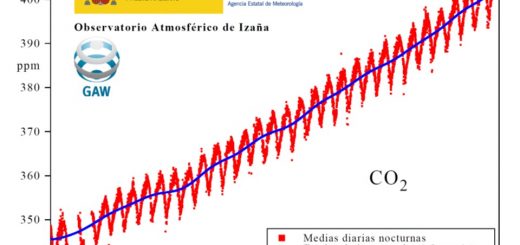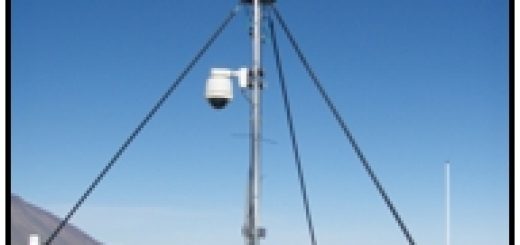Aerosol monitoring program at Izaña Atmospheric Observatory
Objective
The objective is to perform a continuous monitoring of the aerosol properties related to climate forcing and air quality on multi-decadal time scales in the subtropical North Atlantic free troposphere. For this purpose, particle size, chemical composition and optical properties at monitored in a continuous basis. This project is performed within the framework of the Global Atmospheric Watch (GAW) program of the World Meteorological Organization.
Measurements
PARTILAB
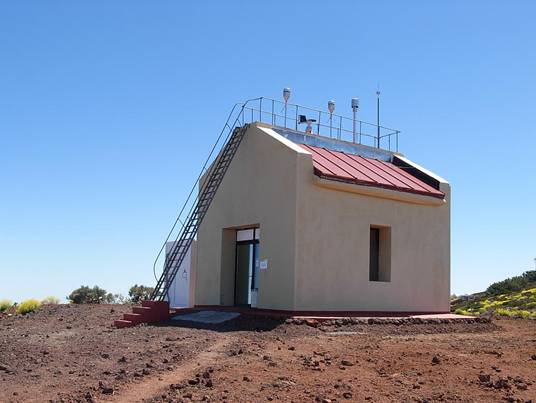
View of the PARTILAB building.
INLETS
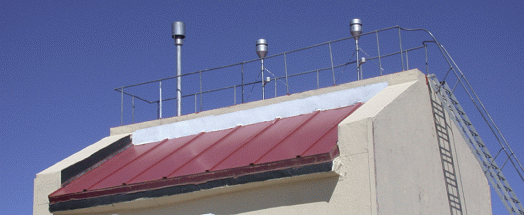
Inlets of the PARTILAB.
RACKS
Two of our particle samplers are installed within independent racks:
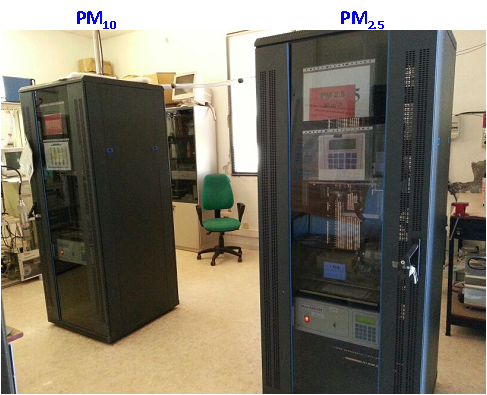
View of two of the sampler in the PARTILAB.
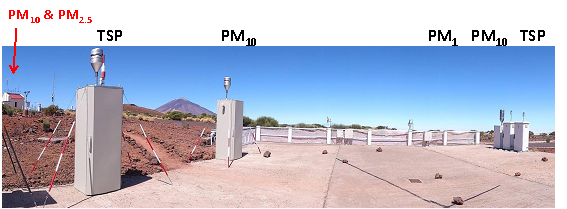
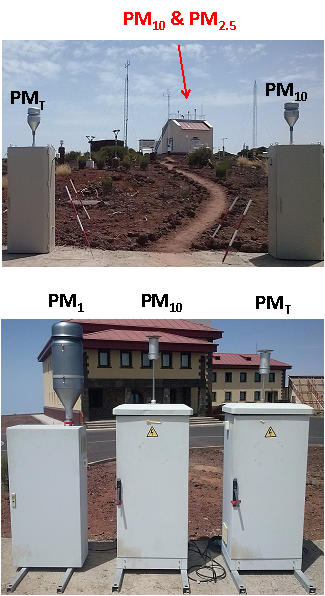
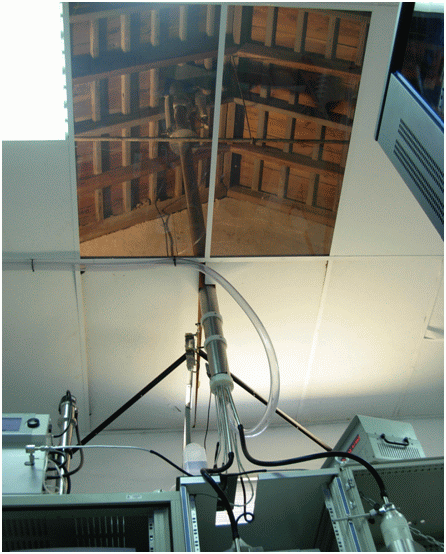
View of the main inlet of the PARTILAB.
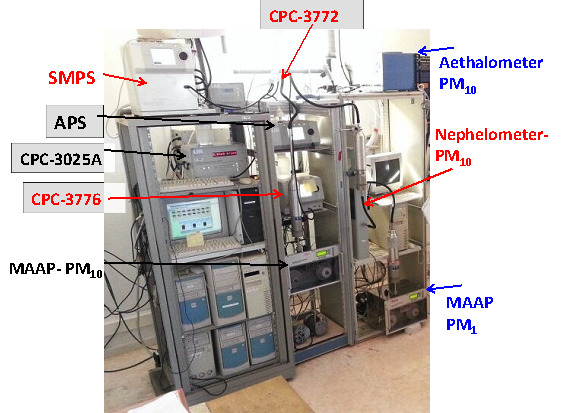
View of the instrumentation used for on line aerosol measurements.
| Parameter | Instrument picture |
|
Number concentrations of particles coarser 3 nm is measured with a TSI™ Ultrafine Condensation Particle Counter model 3025A. |
 |
| Size distribution of particles 9 – 437 nm diameter is measured with a TSI™ Scanning Mobility Particle Sizer (SMPS). A CPC model 3010 and a DMA model 3081 are used. |
 |
| Size distribution of particles 0.5 – 20 µm diameter, measured with a TSI™ Aerodynamic Particle Sizer (APS) model 3321. |
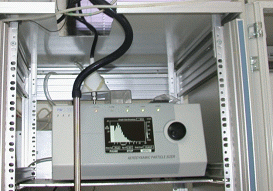 |
|
Mass concentrations and chemical composition of Total Suspended (TSP), less than 10 microns (PM10) and less than 2.5 microns (PM2.5) particles is determined by sampling on quartz micro fiber filter. Mass concentration is determined by gravimetry in our laboratory. Chemical composition allows determining the concentrations of mineral dust, sea salt, sulphate, nitrate, ammonium, organic carbon, elemental carbon, trace elements. |
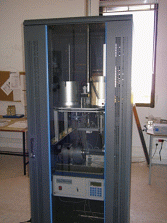 |
| Absorption coefficient at 1 wavelength (630 nm light), due to particles smaller than 10 microns, is measured with a Thermo™ MultiAngle Absorption Photometer (MAAP). A PM10 impactor is placed in the inlet. |
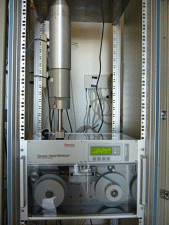 |
| Total-scattering (7-170 degrees) and back-scattering (90-170 degrees) due to particles smaller than 10 microns, is measured at 3 wavelengths: blue (450 nm), green (550 nm) and red (700 nm). A TSI™ Integrating Nephelometer model 3563 is used. A PM10 impactor is placed in the inlet. |
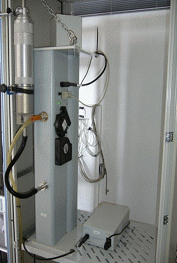 |
More details on the measurements are provided at GAWSIS
Research
Saharan dust transport mainly occurs in summer, when the Saharan Air Layer is westward transported across the Atlantic by passing over the Canary Islands. TSP, PM10 and PM2.5 concentrations are Izaña are usually extremely low due to the clean air conditions in the free troposphere conditions (e.g., the PM10 and PM2.5 median for the 2004-2008 period are equal to 3.5 and 2.2 µg/m3, respectively). Increases in the aerosol mass concentrations are only recorded during Saharan dust transport episodes. High TSP, PM10 and PM2.5 concentrations are only recorded in summer due to dust transport.
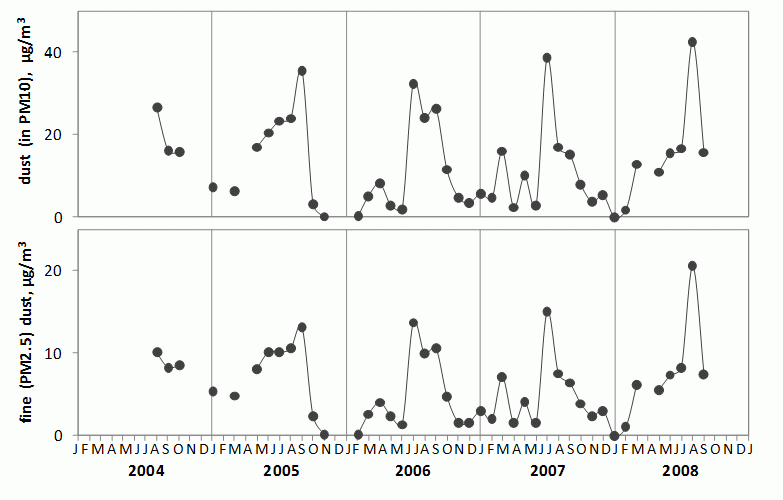
Monthly average values of PM10 and PM2.5 concentrations.
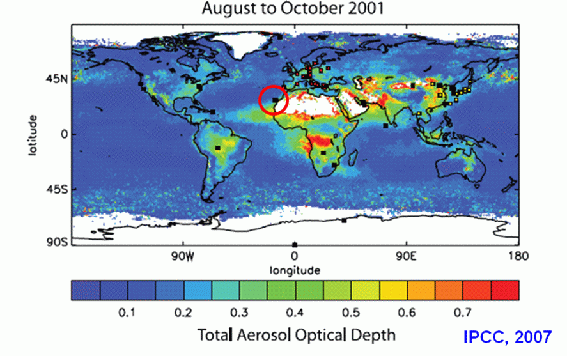
Global Aerosol Optical Depth. Red circle highlights the location of Izaña in the Northern edge of the Saharan Air Layer.

Hourly values of the total scattering coefficient at three wavelengths (700, 550 and 450 nm) and of the PM10 particles concentration.
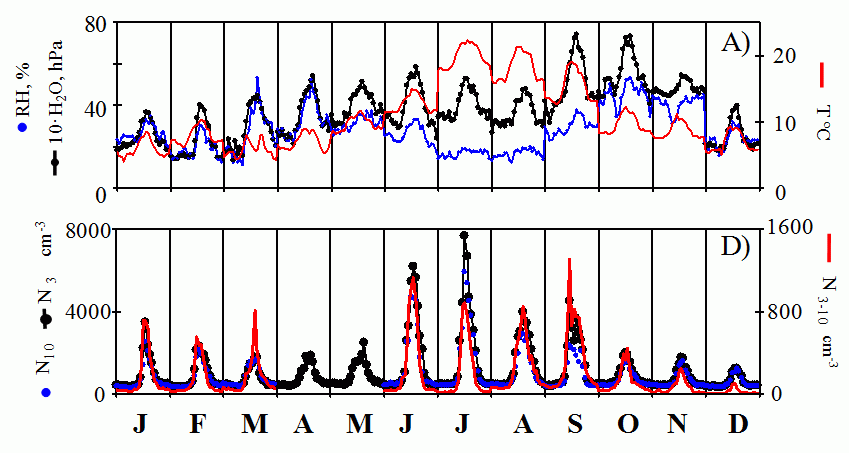
Daily evolution for every month of, relative humidity (RH), water vapor (H2O), temperature (ºC), and the concentrations of particles with a diameters within the range 3-10nm (N3-10), higher than 10nm (N10) and higher than 3 nm (N3).
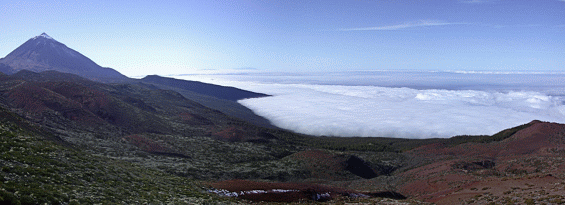
Picture of the northern side of Tenerife (view from Izaña Observatory) showing how the terrain of the island emerges above the marine stratocumulus cloud layer and enters in the low free troposphere.
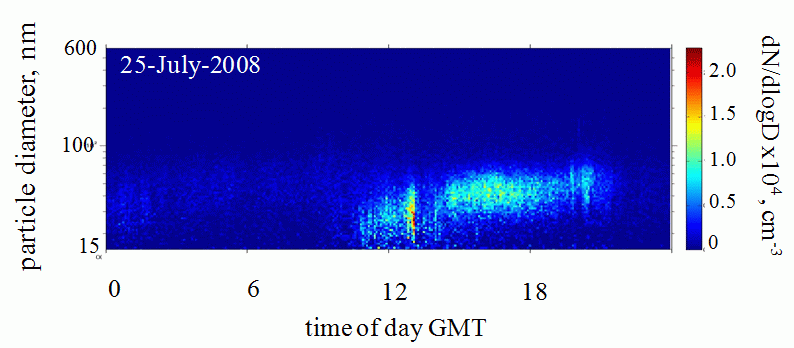
5-minute values of the dN/dlogD size distribution during a new particle formation event.
Visitors for aerosol studies (since 2003)
tr>
| Name |
Institution |
Period |
| Scientist of the MINATROC project | August 2003 | |
| Dr. S. Castillo | Institute of Earth Sciences “Jaume Almera”, CSIC |
August 2003 |
| Prof. J. M. Prospero | RSMAS-University of Miami | August 2005 |
| Dr. K. Kandler | Darmstadt University of Technology | July 2005 |
| Dr. M. Gil and Mr. J.F. López | INTA | July 2005 |
| Dr. M. Gil and Mr. J. Andrey | INTA | July 2006 |
| Dr. T. Tuch and A. Nowak | World Calibration Centre for Aerosol Physics | November 2006 |
| Isabel García Alvarez | University of La Laguna | January – June 2009 |
| S. Scheidt | University of Pittsburgh | July 2009 |
| Fluvio Amato | IDAEA-CSIC | July 2010 |
| Yvonne Boose , Larissa Lacher, Berko Sierau | Institute for Atmospheric and Climate Science of Zürich (ETH) | July-August 2013 |
| Susan Schmidt | Max Planck Institute for Chemistry (MPI-C) | July-August 2013 |
| Yvonne Boose , Fabian Mahrt, Berko Sierau | Institute for Atmospheric and Climate Science of Zürich (ETH) | July-August 2014 |
Publications based on aerosol observations at Izaña
Querol, X., A. Alastuey, M. Viana, T. Moreno, C. Reche, M.C. Minguillón, A. Ripoll, M. Pandolfi, F. Amato, A. Karanasiou, N. Pérez, J. Pey, M. Cusack, R. Vázquez, F. Plana, M. Dall’Osto, J. de la Rosa, A. Sánchez de la Campa, R. Fernández-Camacho, S. Rodríguez, C. Pío, L. Alados-Arboledas, G. Titos, B. Artíñano, P. Salvador, S. García Dos Santos, R. Fernández Patier. Variability of carbonaceous aerosols in remote, rural, urban and industrial environments in Spain: Implications for air quality policy. Atmospheric Chemistry and Physics 13, 6185-6206, 2013. DOI: doi:10.5194/acp-13-6185-2013
García, M. I., S. Rodríguez, Y. González, R. D. García. Climatology of new particle formation events in the subtropical North Atlantic free troposphere at Izaña GAW observatory. Atmos. Chem. Phys. Discuss., 13, 24127–24169, 2013
Rodríguez, S. A. Alastuey, X. Querol. A review of methods for long term in-situ characterization of aerosol dust. Aeolian Research, 6, 55-74, 2012. DOI: http://dx.doi.org/10.1016/j.aeolia.2012.07.004
Schulz, M., J. M. Prospero, A. R. Baker, F. Dentener, L., Ickes, P.S. Liss, N. M. Mahowald, S. Nickovic, C. Pérez García-Pando, S. Rodríguez, M. Sarin, I. Tegen, R. A. Duce. Atmospheric Transport and Deposition of Mineral Dust to the Ocean: Implications for Research Needs. Environmental Sciences and Technology, 46, 10390−10404, ,2012. DOI: dx.doi.org/10.1021/es300073u
Andrews, E., J.A. Ogren, P. Bonasoni, A. Marinoni, E. Cuevas, S. Rodríguez, J.Y. Sun, D.A. Jaffe, E.V. Fischer, U. Baltensperger, E. Weingartner, M. Collaud Coen, S. Sharma, A.M. Macdonald, W.R. Leaitch, N.-H. Lin, P. Laj, T. Arsov, I. Kalapov, A. Jefferson, P. Sheridan. Climatology of aerosol radiative properties in the free troposphere. Atmospheric Research, 102(4), 365-393, 2011. DOI: 10.1016/j.atmosres.2011.08.017.
Rodríguez, S., A. Alastuey, S. Alonso-Pérez, X. Querol, E. Cuevas, J. Abreu-Afonso, M. Viana, M. Pandolfi, and J. de la Rosa. Transport of desert dust mixed with North African industrial pollutants in the subtropical Saharan Air Layer. Atmospheric Chemistry and Physics, 11, 6663 – 6685.
Kandler, K., N. Benker, E. Cuevas, M. Ebert, P. Knippertz, S. Rodríguez, L. Schütz, S. Weinbruch, Chemical composition and complex refractive index of Saharan Mineral Dust at Izaña, Tenerife (Spain) derived by electron microscopy. Atmospheric Environment, 41, 8058–8074, 2007. DOI: 10.1016/j.atmosenv.2007.06.047
Alastuey, A., Querol, X., Castillo, S., Escudero, M., Avila, A., Cuevas, E., Torres, C., P.M. Romero, Exposito, F., García, O., Díaz, J.P., Van Dingenen, R., Putaud, J.P.: Characterisation of TSP and PM2.5 at Izaña and Santa Cruz de Tenerife (Canary Islands, Spain) during a Saharan Dust Episode (July 2002). Atmospheric Environment 39, 4715–4728, 2005.
Maring, H., Savoie, D. L., Izaguirre, M. A., McCormick, C., Arimoto, R., Prospero, J. M., Pilinis, C.: Aerosol physical and optical properties and their relationship to aerosol composition in the free troposphere at Izaña, Tenerife, Canary Islands, during July 1995, Journal of Geophysical Research, 105, 14677–14700, 2000.
Chiapello, I., Prospero, J.M., Herman, J.R., Hsu, N.C., Detection of mineral dust over the North Atlantic Ocean and Africa with Nimbus 7 TOMS. Journal of Geophysical Research, 104, 9277-9291, 1999.

